Ezergailis Andris
Faculty: Electrical Engineering
Cathedra Electrical systems
Speciality: Electrical systems and networks
Qualification work theme: Mathematical modeling of electromechanical transients in turbine generators based on complex equivalent circuits substitution
Project chairman: Larin Arcady
Abstract of the master's work
Mathematical modeling of electromechanical transients in turbine generators based on complex equivalent circuits substitution
Introduction
Currently, the mathematical description of the synchronous machines (SM), the most widely used system of full or differential operator equations of the electromagnetic state (equation Park Goreva). These equations can describe the transient ac machines with the influence of an unlimited number of contours in the rotor. Simulation of transients implies, in this case, the fame given set of active and inductive resistances, reflecting the relationship between currents and flux linkage in a magnetically coupled circuits of the machine. Such background information is presented in the form of equivalent circuits are physically sound structure, with varying degrees of detail.
Differential equations, written on the changes of the rotor flux linkage in axes d, q does not depend on the structure adopted for modeling the equivalent circuit of substitution. The currents used in them are determined from the correlations between the flux linkage with the currents through the proper and mutual inductances of the branches of the equivalent circuit.
The values of their own and mutual impedances are used to reflect the relationship between flux linkage and currents in magnetically coupled circuits, depend on the structure adopted as a mathematical model of the equivalent circuit of substitution. Consequently, for each structure equivalent circuit using a PC requires a related program of calculation. So pressing is the task of developing a method of converting equivalent circuits of various structures to one of the most simple form, convenient for simulation of dynamic regimes.
Topical issue
Currently, electricity is required to improve existing and develop new ways to identify a subset of the electromagnetic parameters of turbo-generators, as well as evaluating the effectiveness of their use to clarify the definition of electromagnetic parameters and mathematical modeling. For each structure equivalent circuit using a PC requires a related program of calculation. So pressing is the task of developing a unified approach to modeling of transients using the equivalent circuits of various structures through their prior conversion to a form suitable for modeling.
Communication with scientific themes, plans and programs
At present known number of theoretical and experimental methods for determining the parameters of electromagnetic EM in the form of frequency characteristics, or equivalent circuits of substitution, taking into account the influence of saturation.[1]
Refined solution to the distribution of currents in the individual circuits of synchronous machines necessitates the determination of dependency inductive resistances scattering as a function of the currents flowing in the respective circuits machines. This problem was solved in the development of methods for determining the frequency characteristics and parameters of equivalent circuits of substitution in the function occurring in the corresponding contour currents.In this scheme of substitution, taking into account various mutual inductance between circuits, obtained according to the parameters of the equivalent damper circuit in function of the initial value of the periodic current in the stator winding for vysokoispolzovannyh industrial turbine generators.
However, the practical consideration of such dependencies in mathematical models of electric machines is very difficult in consequence of the fact that the parameters of equivalent circuits depend on the unknown currents and methods of their use for analysis of short circuit regimes at different levels of saturation is absent.
Objective Development and Researc
The aim of this work is to develop a method of converting complex equivalent circuits of different structures from one species to another. This would provide a universal program for computing to study different types of transients.
Scientific novelty
Scientific novelty lies in the fact that in the context of further development of communication theory frequency characteristic with transients proposes a number of refinements that will improve the accuracy of the totality of electromagnetic parameters of the SM since the following aspects: first, the differences between the time constants for the individual components of a periodic current in the stator Under the scheme of substitution Г-shaped form, and secondly, the influence of parameters on the transverse axis rotor q on a periodic component of the transition current in the stator short circuit, and, thirdly, the definition of the current in the coil excitation of SM given saturation.
Brief description of development and research
The most widely used equivalent circuit, in which it is assumed that the chain of stator windings, excitation and damping circuits are magnetically communicating only through the main magnetic field of mutual reactivity. In such schemes, substitution of T - shaped type (Fig. 1) winding excitation generator (EWG) can be submitted by one circuit, or an independent multiloop circuit.
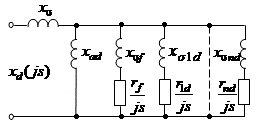
Figure 1 – Equivalent Circuit SM T-type
In some recent work on the construction and use of equivalent circuits refined structure (Fig. 2).They are more reliable from a physical point of view, because they take into account the difference in mutual inductive magnetic coupling between the stator windings, excitation and equivalent circuit damper system.
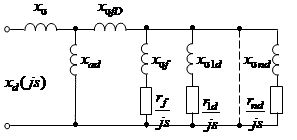
Figure 2 - Scheme of substitution, taking into account varying magnetic coupling between circuits.
When used for modeling equivalent circuits with different magnetic coupling between circuits, as a rule, damping system are simplified as an equivalent circuit.[2]
The staff of the Siberian Scientific-Research Institute of Energy proposed and obtained more complex structures equivalent circuits replacement turbine generators, also taking into account the mutual relationship between different contours, situated on the rotor. The main feature of such schemes is the replacement of the damper system performance cars in the longitudinal and transverse axes of the rotor as the main damper loop covering the magnetic flux of mutual induction between the stator and rotor, and a number of local units, covering the magnetic fluxes of scattering and the excitation winding. In this case, the excitation winding of the generator, its damper system and the mutual inductance between them are characterized by a complicated dependence on high-order slip (Fig. 3).[3]
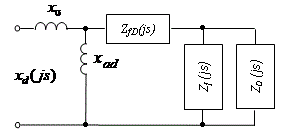
Figure 3 - Scheme of Substitution SM high order
Detailed This scheme looks like Fig. 4:

Figure 4 - Equivalent Circuit turbogenera-torus TGV-200M to the longitudinal axis of the rotor
(performed at the GIF Animator, size 3,85 kb, the number of frames 4, 10 repetitions)
For a general analysis of transients in terms of identifying extreme values of the profile, the differential equations are inconvenient. For these purposes, developed a model of EM, based on the analytical description of the transition.[4]
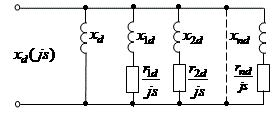
Figure 5 - Scheme of Substitution SM Г-shaped type
When the frequency method for calculating transients is more efficient analytical description of frequency characteristics with L-shaped equivalent circuits with the recommendation made at times a source of a branch of the magnetization (Fig. 5). It should also be noted that this form of information about the totality of electromagnetic parameters of SM is the most convenient in terms of storing it in computer memory and the subsequent identification on the basis of its transition functions.
The general way of transforming equivalent circuits of substitution from one structure to another is the synthesis
of equivalent circuit parameters of the desired structure on a complex frequency response of the input resistance
 or conductance
or conductance  scheme of the original structure.
scheme of the original structure.
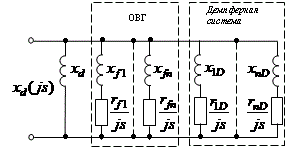
Figure 6 - Equivalent Circuit TG in presenting EWG multiloop circuit
Findings
Proposed changes in the method of equivalent circuits of substitution, based on the adequacy of the frequency characteristics of the conductivity of the stator windings and the complex coefficients of the current distribution in the branches of the stator winding can simplify complex equivalent circuits of high order to the simple form suitable for simulation of transients on the basis of an analytical description of electromagnetic transients.
Bibliography:
Рогозин Г.Г. Об использовании функциональных характеристик при учете влияния насыщения синхронных машин / Г.Г. Рогозин, И.И. Ларина // Изв. АН СССР. Энергетика и транспорт. – 1986. - №6. – С.61-68.
Машины электрические синхронные трехфазные. Методы испытания. ГОСТ 10169-77. М.:Госкомстандарт СМ СССР, 1977.
Казовский Е.Я. Переходные процессы в электрических машинах переменного тока. — М.: Изд-во АН СССР, 1962. — 624 с.
Шапиро А.С. Схема замещения турбогенератора при больших скольжениях с учетом клиньев и торцевого эффекта // Турбо- и гидрогенераторы большой мощности и перспективы их развития. – Л.: Наука, 1969. – С. 153-167.
Larin A. Lamary A. Computer simulation of the transient in AC machines at short-circuits and connections to a network on the basis of the experimental frequency-response characteristics // 9th International Symposium on Short-circuit currents in power systems, SCC'2000, Cracow, October 11-13, 2000. - P. 39-45.
Рогозин Г.Г., Ларин А.М. Расчет параметров эквивалентных роторных контуров синхронных машин по их экспериментальным частотным характеристикам // Электричество. - 1974. - № 6. - С.10-13.
Харченко В.А. О разбросе значений параметров синхронной машины, находимых из опыта внезапного короткого замыкания. // Изв. РАН. Энергетика. 1996. №2. С. 127-137.
Ларин А.М., Рогозин Г.Г. Синтез параметров эквивалентной схемы замещения массивного ротора турбогенератора градиентным методом. / Электричество, 1976, № 11. С.10-13.



